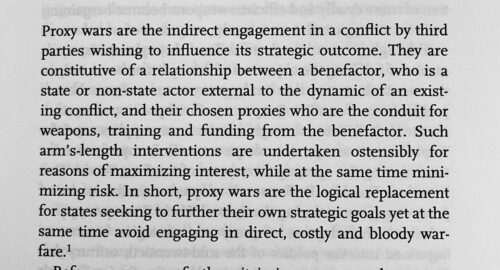
What is proxy war? In short, an alternative course of action to potentially ruinous direct warfare for states still seeking to further their own strategic goals.
Proxy wars represent a perennial strand in the history of conflict. The appeal of ‘warfare on the cheap’ has proved an irresistible strategic allure for nations through the centuries.
Proxy interventions often prolong existing conflicts given the perpetuity of arms, money and sometimes proxy fighters sponsored by third party donors.
Ukraine has been the victim of longterm tensions between Russia and the United States since the end of the Cold War, which de facto did not end. The new phase of the Cold War erupted with Russia annexing Crimea from Ukraine in 2014, and evolves through to the present day. The Minsk II agreement of 2015, assures peace and self-governance in the breakaway regions of eastern Ukraine Donbass, but has never been operational in full force. The bipolar power structure of the world ended with the collapse of the Soviet Union at the end of the Cold War in 1991. However, President Vladimir Putin is engaged in an apparent effort to regain its superpower status and even eventually re-form the old Soviet Union. The geopolitical situation has been a problem since the end of the Cold War for Russia, overshadowing Russia’s attempts to climb higher on the world stage.
The Biden Administration is well aware of it.
This was written last December, well before we were concerned about Ukraine and its citizens.
The United States is planning to redouble its weapons supply to Ukraine. What is shaping up is an intensified proxy war against Russia in which the Russophobic Kiev regime acts as Washington’s catspaw. The objective is to debilitate Russia in the same way the U.S. sapped the Soviet Union with a quagmire war in Afghanistan during the 1980s.
U.S. media reports cite Pentagon and Ukrainian officials saying that the Biden administration is considering a massive increase in armaments to the Kiev regime. This is on top of the $2.5 billion in military support that Washington has already given over the past eight years. The Biden administration has overseen $450 million in weaponry to Ukraine this year alone with a further $300 million budgeted for the coming 12 months. A separate proposal going through the Senate is seeking to boost military support for next year by another $450 million.
How much of the current trouble is actually down to the West?
